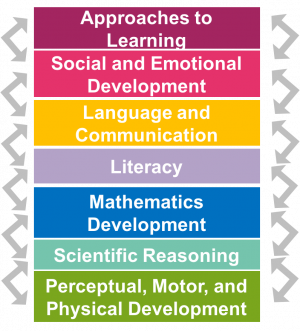11-3 Learning Throughout the Day
A – Learning Throughout the Day
In this lesson, we have discussed how preschoolers’ ability to control themselves (self-regulation) and their ability to engage with the world and others matures considerably between 3 and 5 years of age.
Children learn these skills together, which helps them develop complex actions. They also do not learn these skills as sudden epiphanies—there are no aha moments.
Instead, children gradually use skills more consistently. One day, they may regulate their emotion well during one social encounter, only to drop to the floor in a tantrum at the next social encounter. Eventually, and with adult guidance, children begin to regulate their emotions more consistently throughout different events.
Every event of every day is an opportunity for children to practice and further develop these skills.
B – Domains of Development

During the previous lesson, we watched infants and toddlers throughout key activities in their day. In this lesson, we’ll view videos from different preschool environments throughout the day.
Keep in mind how the skills that you are observing in the videos relate to skills in other domains. Learning and development always happen in context, and rich, supportive learning environments, such as the ones that we are about to observe, help to support the whole child as they grow.
Video Gallery
As you did the last lesson, think about the skill-building moments in each video and how educators are supporting the children in their development.
Video: Whose Shirt? (2:21)
Video: Transitions (1:35)
Video: Pass the Bananas (3:55)
Video: Building Towers (3:14)
Video: Shapes on the Light Table (2:43)
Video: Talking about Animals (3:15)
Video: Countdown to Cleanup (2:04)

Reflection Point
In this section, we have talked about how preschoolers learn and build skills through their everyday experiences. Now, take a moment to consider how children’s behaviors in these videos differ from those of the infants and toddlers who we watched during routine activities in last lesson.
- Did children engage in similar activities? If so, how did educators interact with older and younger children differently, even when children were engaging in the same tasks?
- What are some expectations that you have for infants, toddlers, younger preschoolers, and older preschoolers during everyday tasks?
- Did you notice any differences in how educators talked to older and younger children?
 References
References
Cultivate Learning (Producer). (2017). Building towers. University of Washington. [Video File]
Cultivate Learning (Producer). (2017). Countdown to cleanup. University of Washington. [Video File]
Cultivate Learning (Producer). (2017). Pass the bananas. University of Washington. [Video File]
Cultivate Learning (Producer). (2017). Shapes on the light table. University of Washington. [Video File]
Cultivate Learning (Producer). (2017). Talking about animals. University of Washington. [Video File]
Cultivate Learning (Producer). (2017). Transitions: How should I do it? University of Washington. [Video File]
Cultivate Learning (Producer). (2017). Whose shirt? University of Washington. [Video File]
EarlyEdU Alliance (Publisher). (2018). 11-3 Learning throughout the day. In Child Development: Brain Building Course Book. University of Washington. [UW Pressbooks]

